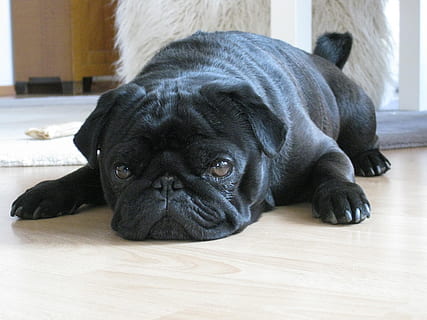Hello ladies and gents this is the Viking telling you that today we are talking about
Fun Facts About Pugs
Pugs are well-known for their wrinkled faces, barreled chests, and charming personalities. These friendly, mischievous little dogs aim to please and make great companions. Learn more about this dog breed in these 10 fun facts about Pugs!
1. The Pug is one of the oldest dog breeds.
Pugs have been around since before 400 BC. This ancient dog breed originated in China, where they lived in Buddhist monasteries in Tibet. Pugs were originally intended to serve as lapdogs for Chinese emperors. According to the American Kennel Club (AKC), the ancient Chinese emperors had a preference for flat-faced toy dogs. The Shih Tzu, Pekingese, and Pug were all developed as refined pets of the emperor and his family, as well as members of the imperial court. Similar to the Lhasa Apso, Pugs were highly regarded dogs that were often given as gifts. Because Pugs were so treasured, outsiders could only acquire one as a gift.
2. Their name probably comes from their facial expression.
Although it hasn’t been confirmed, many people think that the name “Pug” comes from the dog’s facial expression. A Pug’s facial expression is similar to that of marmoset monkeys, which were also known as Pug monkeys. These monkeys were popular pets in the early 1700s. Another theory suggests that the Pug name comes from the Latin word for “fist,” which is “pugnus,” because a Pug’s face resembles a clenched fist.
3. The Pug was the mascot of the House of Orange in Holland.
A Pug saved the life of the Prince of Orange in the 1500s during a revolt against the Spaniards. William’s pug, Pompey, barked to warn the prince of an attack on his camp by Spanish troops. After that, the dog breed became the official dog breed of the House of Orange in Holland. According to the AKC, “When William and Mary of Orange arrived in England to assume the monarchy, their Pugs accompanied them and began a craze for the breed among the British.” They also claim that a Pug appears in the effigy of the monarch over William’s tomb.
4. The Pug has many different names.
Because the Pug has experienced worldwide popularity, they have acquired many different names during various time periods and places. Some of these names include Lo-sze (China), Doguillo (Spain), Chinese or Dutch Pug (England), Mops (German), Mopsi (Finland), and Mopshond (Holland).
5. They are not related to Bulldogs.
Although they are sometimes called “Dutch Bulldogs,” DNA testing has proven that Pugs and Bulldogs are not related. The two breeds do have similar features, including their wrinkles, flat face, and stocky shape. However, the Pug shares its origins with the Pekingese.
6. A Pug was the symbol of the Freemasons.
After the Catholic Church banned Freemasonry, a group of Catholics formed a secret Freemason society called the Order of the Pug in 1740. They chose the Pug as their symbol because the dog breed is trustworthy and loyal.
7. Their coat requires minimal maintenance.
Pugs have a short and smooth coat which requires minimal maintenance. It’s important to note that pugs shed; regular brushing can help remove loose hair and reduce shedding. Pugs can come in three different colors, including all black or apricot-fawn or silver with a black face mask. Their facial wrinkles must be kept clean to help prevent skin fold dermatitis.
8. Pugs don’t need much exercise.
Compared to other dogs, Pugs generally don’t need as much exercise. Most Pugs will happily spend their days snuggling and relaxing on the couch. However, these small dogs also like to eat, which can put them at a higher risk of obesity. Pug owners should ensure their dog gets moderate exercise, like walks, to help keep their pet at a healthy weight.
9. They can’t tolerate hot weather.
Pugs are a brachycephalic dog breed, which means they are flat-faced and shorter-nosed. This can lead to respiratory distress in some dogs and make it more difficult to breathe during exercise, stress, or in the heat. Most Pugs can’t handle strenuous exercise or hot/humid conditions. Because of this, it’s best to keep Pugs in an air-conditioned area during the summer.
10. Pugs are generally healthy.
Pugs are generally healthy dogs that live an average of 12 to 15 years. Common health problems in Pugs include Pug Dog Encephalitis (PDE), hip dysplasia, obesity, skin infections, and eye problems like corneal ulcers and dry eye. Because of their flat face, they are more prone to heat sensitivity, snoring, and wheezing. It’s important to remember that it’s difficult to predict when or if your dog will become injured or sick. Pet insurance can help by offsetting the cost of vet bills if your Pug would become sick or injured.
Bonus fact: Pugs are predisposed to developing kidney or bladder stones. These stones can cause a lot of discomfort and often end up in costly surgery. You can help minimize the chance of stone formation with Thomas Vet’s Cal Ox, which minimizes available oxalates, limits crystallization, and supports ideal urine pH and flow.
and as always have a chilled day from the Viking

Comments
Post a Comment